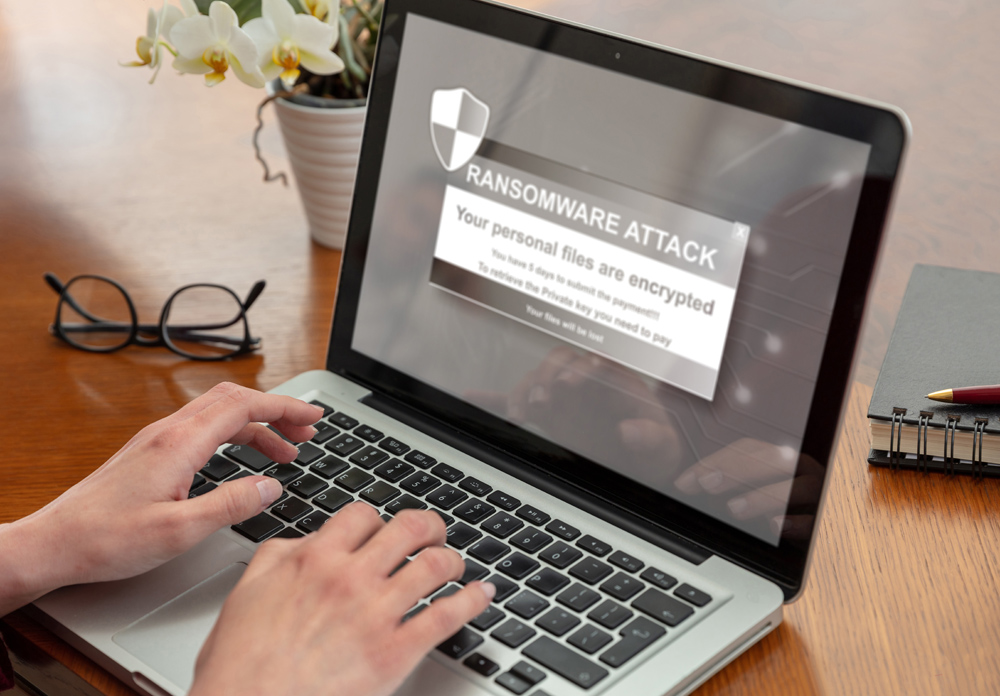Ransomware is a type of malware attack that attacks computers and locks up sensitive information. This includes documents, emails, pictures, videos, music, etc. When ransomware infects a computer, it typically hides inside another program that appears legitimate — like Microsoft Word or Adobe Acrobat Reader. Then, once the user opens the file, it executes automatically.
After gaining control of the system, the hacker starts encrypting the data stored on the machine. When the encryption process is complete, the hacker demands money from the victim in exchange for the decryption key. Victims usually pay up because they don’t want to risk losing their data. However, some victims choose to fight the hackers and refuse to pay. As a result, the hackers delete the data and lock the victim out of their network.

Table of Contents
How Do Ransomware Attacks Work?
Ransomware has become one of the most popular types of malware today. The reason why is simple: it’s easy to spread. Once you download an infected file, it can be shared with all your contacts. Making it very difficult to track down where the infection originated.
The good news is that there are ways to protect yourself from this threat. For example, you should always install software only from trusted sources and avoid clicking on links in unsolicited email messages. You must also keep your operating systems updated with the latest security patches. Finally, make sure that all of your passwords are strong and unique.
How To Avoid Ransomware Attacks?
If you’re using Windows 10 or 11, we recommend using SentinelOne’s Autonomous AI Endpoint Security Platform for protection. It scans files as soon as they arrive on your device and prevents them from executing. If any suspicious activity is detected, it notifies you so you can take action immediately.
Antimalware software is another way to prevent ransomware attacks. Security software scans your computer for malicious code every time you start it up. They’ll detect new threats before they have a chance to execute.
You can use cloud-based services such as Azure and AWS to store important files. These services provide extra security by keeping copies of your data online. That way, even if someone manages to steal your laptop, they won’t get access to your most valuable files. Furthermore, by saving your data off-premise, your backup files will be safe from cyber-attacks.
The last way is offline backups, which means backing up your data manually. While this method may seem tedious, it provides the best level of security. Plus, you can back up your data whenever you feel like it without worrying about having enough space on your hard drive. It’s a bit old school, but it works and can keep you safe from ransomware threats.
Note that there is a sense of urgency when dealing with ransomware. Please don’t wait until it’s too late!
What To Do After a Ransomware Attack?
The good news is that there are ways to recover lost data without paying a ransom. Here are three options:
1. Contact Your IT Team or MSP
Your first step should be contacting your IT team or managed service provider (MSP). They can help restore your files and ensure your business stays protected.
2. Restore From A Backup
If you backed up your computers before the infection, you might be able to restore your files. You’ll want to ensure you have a recent system backup because if you don’t, you could lose everything.
3. Don’t Panic!
This should probably be #1, but try to stay calm. Keeping a level head could mean the difference between getting your files back and losing your data and money.
4. Reimage Your System
Have your IT team reimage your system. This process involves taking an image of your entire hard drive and restoring it onto a clean machine. Once you’ve done this, you’ll be free from the ransomware.
5. Contact Your Cyber Insurance Provider
If you have cyber insurance, contact your insurer. They may offer assistance in recovering your files, and you’ll need to contact them to let them know what happened.
6. File a Police Report
You’ll need to file a police report with your local law enforcement agency because you were victimized by a crime. The report will give authorities all the information they need to attempt to track down the person who infected your computer. Filing a police report can save you later down the line, and your cyber insurance provider will need it. Contacting the FBI would also be a great idea.
7. Pay The Ransom
You’ll need to pay the ransom if you don’t have backups and cannot restore your files. However, you shouldn’t pay unless you have no other choice. There are many stories of people getting their files restored after paying the ransom, but this also might make you an easy target for future cyber threats.
8. Notify Your Customers
Many businesses choose not to notify their customers when they have suffered an attack, but you should consider doing so. If you haven’t already, you should create a plan for informing your customers. Will you send out emails or post something on social media? How will you handle any questions that come up?
9. Consider Hiring An Experienced Lawyer
If you hire an attorney, you’ll want to find one specializing in cybersecurity. They can advise you on whether or not you should pay the ransom and negotiate with the attacker.
Why Are Ransomware Attacks Spreading?
Malware authors constantly develop new ways to infect users’ devices. One of the newest methods involves creating fake websites that look legitimate. These sites trick unsuspecting users into downloading malware. Many of the top threats today come from phishing emails. Phishing emails are designed to appear as though they were sent from someone you trust. They contain links to websites where you can enter personal information. When you visit those websites, you unknowingly give away sensitive data.
Many types of ransomware exist, including Cryptolocker, Locky, Cerber, Petya, and WannaCry. Most of these will encrypt your files and send you a ransom note. You’ll then have a certain amount of time to pay the ransom before your files become inaccessible.

What Types of Businesses Are Prime Ransomware Targets?
1. Small Businesses
Smaller companies often lack the resources necessary to protect themselves against cyberattacks. They’re less likely to invest in anti-virus software, firewalls, and other technologies that can help prevent malware infections. And even if they do take steps to secure their networks, they may not have enough people to monitor those systems 24/7. This makes small businesses vulnerable to attack.
2. Government Agencies
Government agencies are generally better funded than most small businesses. Their budgets allow them to hire more IT personnel and purchase additional tools to combat cyber threats. However, they still face challenges. Many federal employees work remotely, so they must rely on cloud-based email solutions and shared drives to store documents. These solutions are inherently insecure, meaning they’re susceptible to phishing scams and other malicious activity.
Local government agencies are also prime targets. Local governments typically don’t have the same budget constraints as state or national agencies. But they still face similar problems. For example, local governments often use outdated technology and share network connections with neighboring municipalities. Both factors make them vulnerable to cyberattacks.
3. Medical Centers
Ransomware attacks against healthcare organizations are on the rise. Hospitals and medical clinics are especially vulnerable to ransomware attacks because they deal with highly confidential information. Patients’ records contain personal information such as Social Security numbers, insurance claims, and financial statements. If a hacker gains access to this information, they could use it to commit identity theft or fraud. Many healthcare organizations do not take cybersecurity seriously, making them prime targets for hackers. In addition, healthcare providers often need to exchange confidential patient information with each other. Hackers could intercept this information and sell it for profit.
4. Retailers
Retail stores are another group of businesses that are frequently targeted by cybercriminals. Hackers steal credit card information from point-of-sale terminals and then sell the stolen data online. They also target retailers’ payment processing services, which allows them to drain accounts without leaving any trace of the crime.
5. Financial Institutions
Banks are another group of organizations that are particularly vulnerable to ransomware attacks. Hackers can easily gain access to bank accounts by using social engineering techniques. For example, they might pose as customers and ask for account balances or PIN codes. Once they get these details, they can transfer funds from the victim’s account to their own.

How Can We Help?
We understand that ransomware is a serious threat. That’s why we use SentinelOne’s Autonomous AI endpoint security platform to detect and block malicious activity at the network edge. Our technology automatically blocks suspicious traffic and stops malicious code from reaching your endpoints. It helps prevent infections like ransomware and prevents hackers from accessing your network.
Employee Education and Training
The best way to prevent cyberattacks is through employee education and training. Employees should know how to recognize suspicious behavior and report it to IT staff. They should also know how to properly handle sensitive information such as financial documents and intellectual property.
Infinity Solutions uses a combination of tools to train and test employees. We randomly send out emails that contain phishing and malware attachments to see who clicks on them and then teach them why they shouldn’t. We also conduct random audits of your network to ensure that all employees are following proper procedures.
Security Awareness Training
In addition to educating employees, we provide security awareness training to help them identify potential risks. This helps ensure that all employees are aware of the latest threats and take appropriate action.
IT Staff Training
As mentioned earlier, employees are often the weakest link in cybersecurity. Therefore, IT staff needs to undergo regular training to spot potential threats and act accordingly. We can help train your in-house IT staff so they’re able to detect and respond to any potential threats.
Wrapping Up
How does ransomware work? Most ransomware infections occur because someone opens a phishing email attachment or downloads a virus-infected file. In either case, the attacker gains control over the infected machine. Once inside, the attacker deploys the ransomware. They might use social engineering tactics such as sending emails to trick people into clicking on a link or downloading a file. Or they might use a zero-day exploit to gain remote code execution. Either way, once the ransomware is installed on an infected device, it starts working silently in the background.
Once they get control of the machine, the ransomware begins encrypting files. Most ransomware targets individual files rather than whole folders. When it finishes encrypting everything, it displays a screen saying something like, “Your files have been encrypted.” The encryption becomes permanent if you don’t pay the ransom within 24 hours.
Depending on the type of malware used, the ransomware attackers may demand anywhere from a few thousand dollars to hundreds of thousands or more. Unfortunately, the only way to decrypt these files is by paying the ransom payment. You can try using ransomware decryption tools, but there’s no guarantee they will work.
1. Never open any attachments from anyone you don’t know. You never know if it’s a malicious attachment.
2. Always make sure that you’re running the latest version of your operating system.
3. Keep all of your important files backed up somewhere else.
4. Try to stay away from shady websites.
5. Don’t click links in spam emails to avoid phishing attacks.
6. Use strong passwords and change them regularly.
Cyber criminals are out in full force, trying to infect computers with malware, and it’s quite easy for them to find victims. The best thing you can do is be careful about what you download and where you go online. Through vigorous training, backing up data, and staying vigilant about security threats, you can minimize the risk of becoming a victim of ransomware. If you’d like to schedule a cybersecurity audit, please send us a message. Stay safe!





Recent Comments